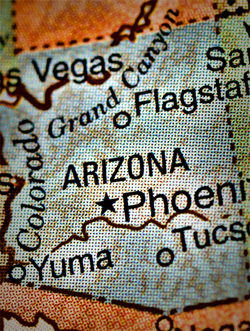
Yesterday's Wall Street Journal featured a reasonably balanced look at the economic effects of Arizona's crackdown on illegal immigrants. The state has enjoyed a 40 percent decline in its illegal population since it mandated E-Verify and empowered local police to check immigration status during traffic stops. (Because Arizona's decline is larger than in surrounding states, we may plausibly attribute it to the new policies.) The Journal points out that fewer illegal immigrants has meant less overall economic output for Arizona, but also higher wages in some sectors and less of a financial strain on schools and hospitals.
Sorting through these different effects can be tricky, and it tripped up even Kevin Drum, a sharp-minded liberal blogger for Mother Jones. Reacting to the Journal piece, Drum noted that Arizona's annual GDP is $6 billion lower because of the new policies, whereas schools and hospitals are saving only $410 million. "Arizona is paying a high price for cracking down on illegal immigration," Drum concluded.
But Drum seems to assume that the benefits of a higher GDP accrue to Arizonans. As CIS's Steven Camarota pointed out in congressional testimony, gains in GDP and gains to the native-born are very different things. Most GDP gains from immigration are captured by the immigrants themselves.
To see that more clearly, imagine that the United States clones itself. From our population of 323 million, we create another 323 million people whose distribution of skills exactly mirror that of the existing population. The clones also come with a stock of capital equipment identical to the country's pre-existing capital. By doubling labor and capital, we double our GDP. "Cloning is essential to our economy," advocates declare. "Without it, we would be only half as rich as we are now." Is that argument persuasive?
Of course not. The clones make the U.S. economy larger, but per-capita income stays the same, leaving the average person no better off than before. Put another way, the clones double the economic pie and then promptly eat half of it themselves.
Admittedly, the reality of immigration is more complicated than the cloning story. Because the skill distribution of real-world immigrants (unlike clones) is different from that of natives, immigration generates some complementarities in the labor market. That means a small slice of the new GDP pie does go to natives. But emphasis on the word small. In a recent paper for CIS, economist George Borjas estimated that immigrants (legal and illegal) added about $1.6 trillion to the U.S. economy. Of that $1.6 trillion, however, just $35 billion (2.2 percent) went to natives.
A different mix of immigrants could produce larger effects, but the gains to natives will always be small relative to GDP growth. In addition, those gains necessarily involve a redistribution from labor to capital. Because immigration lowers wages and hence the cost of production, employers and consumers benefit, while the workers with whom immigrants compete suffer. In other words, employers and consumers eat the small new slice of GDP pie that goes to natives, then they help themselves to a forkful of labor's pre-existing portion.
The Journal article hints at this when it describes how having fewer illegal immigrants has led to higher wages in some sectors. Employers of low-skill labor in Arizona now must put real effort into convincing people to work for them:
Wages rose about 15% for Arizona farmworkers and about 10% for construction between 2010 and 2014, according to the Bureau of Labor Statistics. Some employers say their need for workers has increased since then, leading them to boost wages more rapidly and crimping their ability to expand.
Before the immigration crackdown, Precise Drywall Inc., of Phoenix, would deploy 50 people for jobs building luxury homes. "I could pull out phone books where I had 300 or 400 guys' numbers" to fill out crews, recalls company President Jeremy Barbosa. No longer. Many immigrants left and haven't returned, while other workers moved on to other industries.
"Now you have to put out feelers, buy ads, go on Craigslist, tap job agencies just to get a few men," says Mr. Barbosa. "Growth is based on the ability to hire."
This should be music to the ears of progressives such as Kevin Drum, and really to anyone who is concerned about work opportunities for less-skilled Americans. Although the long-term decline in employment among lower-skill natives is well known, the scale is remarkable. For example, as recently as the fourth quarter of 2000, 74 percent of native-born Americans (ages 18 to 65) with only a high school education held a job. In the fourth quarter of 2015, the number was down to 65 percent. For natives without a high school diploma, employment went from 52 percent to 42 percent over the same period. That last statistic bears repeating: Less than half of working-age natives without a high school degree have a job.
Immigration is not the only cause of the decline in work, of course. Among other factors, something seems to have happened to the work ethic of low-skill Americans that need serious attention. But increasing low-skill immigration can only exacerbate the problem, and making employers more determined to recruit natives can only help.
In tackling difficult policy issues related to immigration, it is important not to be blinded by the large GDP increases that immigrants bring. The average native sees very little of those GDP gains. For low-skill natives, there is a loss.
Jason Richwine is an independent public policy analyst and contributing writer to National Review.
